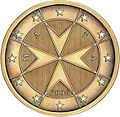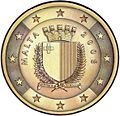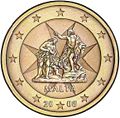Malta Euro Coins
Malta has been a member of the European Union since 1 May 2004, and is a member of the Economic and Monetary
Union of the European Union. It has completed the third stage of the EMU and adopted the euro as its official
currency on 1 January 2008. On 16 May 2007, the Commissioner for Economic and Financial Affairs of the EU,
Joaquin Almunia, recommended that Malta adopt the euro as scheduled, a decision confirmed by the Council of F
inance Ministers on 10 July 2007.
The selection of the designs of the coins was decided by public consultation in two rounds. The first round of
the consultation process started on January 14, 2006 and ended on January 29, 2006. During this period the Maltese
public could participate in the process by choosing from a total of 12 options, divided into 4 design themes
- Prehistoric Malta, Renaissance Malta, The Maltese Identity and The Maltese Archipelago and three different options
were presented for each theme.
The results of the first round voting were The Baptism of Christ in St John's Co-Cathedral (3498 votes), Malta's
Coat of Arms (2742 votes) and Mnajdra Temple Altar (1872 votes). Another design, The Fort St. Angelo option, received
2037 votes, but was not included as one of the three chosen options since the Baptism of Christ received the most
votes in that theme.
Along with the visual design options, the public was also given several alternative options, which were voted on
in the same manner. The first and second most popular suggestions made by the public were the Maltese cross and Dun
Karm, respectively on the Maltese euro coin set. The Steering Committee for the adoption of the euro ultimately
decided to include the most popular suggestion, the Maltese Cross, with the three chosen by the public.
| 1st Place | 2nd Place | 3rd Place | 4th Place |
|---|
| Maltese cross | Maltese coat of arms | Mnajdra temple | Baptism of Christ |
|---|
 |
 |
 |
 |
These four finalists were then sent to a designer and four designs were rendered for the second round of
voting. During the second phase, running from 29 May until 9 June 2006, the public was asked to choose the actual
designs for the euro coins from the four mock ups produced by the designer. The three designs with the highest
number of votes would then become the final design for the Maltese face of the euro coin set. The results of the
second round were Maltese cross, followed by the Coat of arms of Malta and the Mnajdra Temples. The Central Bank
of Malta released the final designs of the euro coins on 19 February 2007. On 23 October 2007, the designs were
officially published in the Official Journal of the European Union and are the work of Noel Galea Bason.
The Maltese 2 euro coin edge inscription
| Edge |
|---|
 |
| |
| The number 2 and two Maltese crosses repeated six times alternately upright and inverted |
Mintmarks on Maltese euro coins
| Mintmark | Location |
|---|
| F | Inside the 6 o'clock star |
The Maltese Euro coins are minted by Monnaie de Paris (Paris Mint).
In 2011, Malta issued the second set of plain circulation coins since the adoption of the common european currency in 2008.
The design of the coins offered a small suprised, as all the coins minted in 2008 had the letter F (mintmark) in the 6 o' clock
star since they were all minted at the Monnaie de Paris. In 2011 this mintmark was dropped as the coins were struck at the
Dutch Mint. Curiously enough, the
Maltese 2 euros 2009 EMU commemorative
coin was also minted at the Dutch mint, but included the old mintmark. Another change on the 1, 2 and 5 cent coins was
the initials of the designer (NGB), which are missing in the new design.